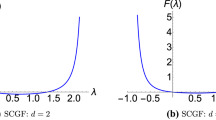Summary
Based on the concept of a bubble electron and the approach of Pais and Uhlenbeck, we construct a finite quantum electrodynamics which is relativistically invariant, macrocausal and unitary. In this model, fields and their interaction are local, but the action function of free fields is nonlocal. The propagators are modified so that a fundamental lengthL is naturally introduced to physics. The modified static potential is given byV(r)=e/r forr>L andV(r)=0 forr<L, which is produced by the bubble sourcer −1dδ(r−L)/dr rather than by a point source. We find thatL<4·10−15 cm. Experimental consequences and modifications of strict causality at short distances |s 2|∼L 2 are discussed.
Riassunto
Basandosi sul concetto di elettrone a bolle e sull’approccio di Pais e Uhlenbeck, si costruisce una quantoelettrodinamica finita che è relativisticamente invariante, macrocausale e unitaria. In questo modello, i campi e la loro interazione sono locali, ma la funzione d’azione dei campi liberi è non locale. I propagatori sono modificati cosicchè una lunghezza fondamentaleL è naturalmente introdotta nella fisica. Il potenziale statico modificato è dato daV(r)=e/r perr>L eV(r)=0 perr<L, che è prodotto da una sorgente a bollar −1dδ(r−L)/dr piuttosto che da una sorgente puntiforme. Si trova cheL<4·10−15 cm. Si discutono le conseguenze sperimentali e le modificazioni della stretta causalità a brevi distanze, |s 2|∼L 2.
Резюме
На основе концепции пузырькового электрона и, используя подход Пейса и уленбека, мы конструируем конечную квантовую электродинамику, которая является релятивистски инвариантной, макропричинной и унитарной. В этой модели поля и взаимодействие являются локальными, но функция действия свободных полей является нелокальной. Пропагаторы модифицируются таким образом, что фундаментальная длинаL вводится естественным образом. Модифицированный статический потенциал задается следующим образомV(r)=e/r дляr>L иV(r)=0 дляr<L. Такой вид потенциала скорее дает пузырьковый источникr −1dδ(r−L)/dr, а не точечмый источник. Мы находим, чтоL<4·10−15 см. Обсуждаются экспериментальные следствия и модификации точной причинности на малых расстояниях, |s 2|∼L 2.
Similar content being viewed by others
References
A. Pais andG. E. Uhlenbeck:Phys. Rev.,79, 145 (1950);M. Born:Rev. Mod. Phys.,21, 463 (1949);S. Fubini: inProceedings of the XVII International Conference on High-Energy Physics (London, 1974).
W. Heitler: inThe Quantum Theory of Fields, edited byR. Stoops (New York, N. Y., 1962);R. P. Feynman:Theory of Fundamental Processes (New York, N. Y., 1962), p. 139;N. Nakanishi:Suppl. Prog. Theor. Phys.,51, 1 (1972).
J. P. Hsu:Lett. Nuovo Cimento,19, 655 (1977). See alsoFound. Phys.,8, 371 (1978), appendix p. 388–390.
E. C. G. Sudarshan:Fields and Quanta,2, 175 (1972);M. E. Arons, M. Y. Han andE. C. G. Sudarshan:Phys. Rev.,137, B 1085 (1965).
T. D. Lee andG. C. Wick:Phys. Rev. D,2, 1033 (1970).
A. I. Akhiezer andV. B. Berestetskii:Quantum Electrodynamics, translated byG. M. Volkoff (New York, N. Y., 1965), p. 185.
P. A. M. Dirac:Phys. Rev.,73, 1092 (1948).
A. Pais andG. E. Uhlenbeck:Phys. Rev.,79, 145 (1950).
H. Yukawa:Phys. Rev.,76, 300 (1949); see alsoM. Fierz:Phys. Rev.,78, 183 (1950);Y. Katayama: inProceedings of the 1967 International Conference on Particles and Fields, edited byC. R. Hagen, G. Guralnik andV. A. Mathur (New York, N. Y., 1967).
H. S. Green:Proc. Roy. Soc.,197, 73 (1949);T. Chang:Proc. Camb. Phil. Soc.,42, 132 (1946);44, 76 (1948).
The result holds even if one chooses a bilinear gauge condition.J. P. Hsu:Phys. Rev.,8, 2610 (1943); see alsoJ. P. Hsu andJ. A. Underwood:Phys. Rev.,12, 620 (1975).
The integral for the electron self-energy is somewhat complicated. It is approximated by takingL −1→∞ in one of the two modified propagators and the result is already finite. This approximation will give the upper bound and the correct order of magnitude for the self-energy.
J. J. Sakurai:Advanced Quantum Mechanics (London, 1967), p. 275.
J. M. Jauch andF. Rohrlich:The Theory of Photons and Electrons (Cambridge, Mass., 1955), p. 191.
Particle Data Group:Review of Particle Properties (1976).
We would like to thank Prof.H. P. Stapp for discussions of this topic.
N. G. Van Kampen:Phys. Rev.,89, 1072 (1953);91, 1267 (1953).
See, for example,J. P. Hsu:Phys. Rev. Lett.,36, 646, 1515 (1976);Phys. Rev. D,9, 810, 1313 (1974);10, 3836 (1974); and ref. (2,11)W. Heitler: inThe Quantum Theory of Fields, edited byR. Stoops (New York, N. Y., 1962);R. P. Feynman:Theory of Fundamental Processes (New York, N. Y., 1962), p. 139;N. Nakanishi:Suppl. Prog. Theor. Phys.,51, 1 (1972). The result holds even if one chooses a bilinear gauge condition.J. P. Hsu:Phys. Rev.,8, 2610 (1943); see alsoJ. P. Hsu andJ. A. Underwood:Phys. Rev.,12, 620 (1975). A simple non-Abelian model has been carried out in detail, seeJ. P. Hsu: NASA (MSFC) Space Sciences Laboratory preprint series No. 78-119 and 78.120 (1978).
Author information
Authors and Affiliations
Additional information
Work supported in part by the U.S. ERDA.
Traduzione a cura della Redazione.
Переведено редакцией.
Rights and permissions
About this article
Cite this article
Hsu, J.P., Mac, E. Fundamental length, bubble electrons and nonlocal quantum electrodynamics. Nuov Cim B 49, 55–67 (1979). https://doi.org/10.1007/BF02737474
Received:
Published:
Issue Date:
DOI: https://doi.org/10.1007/BF02737474



